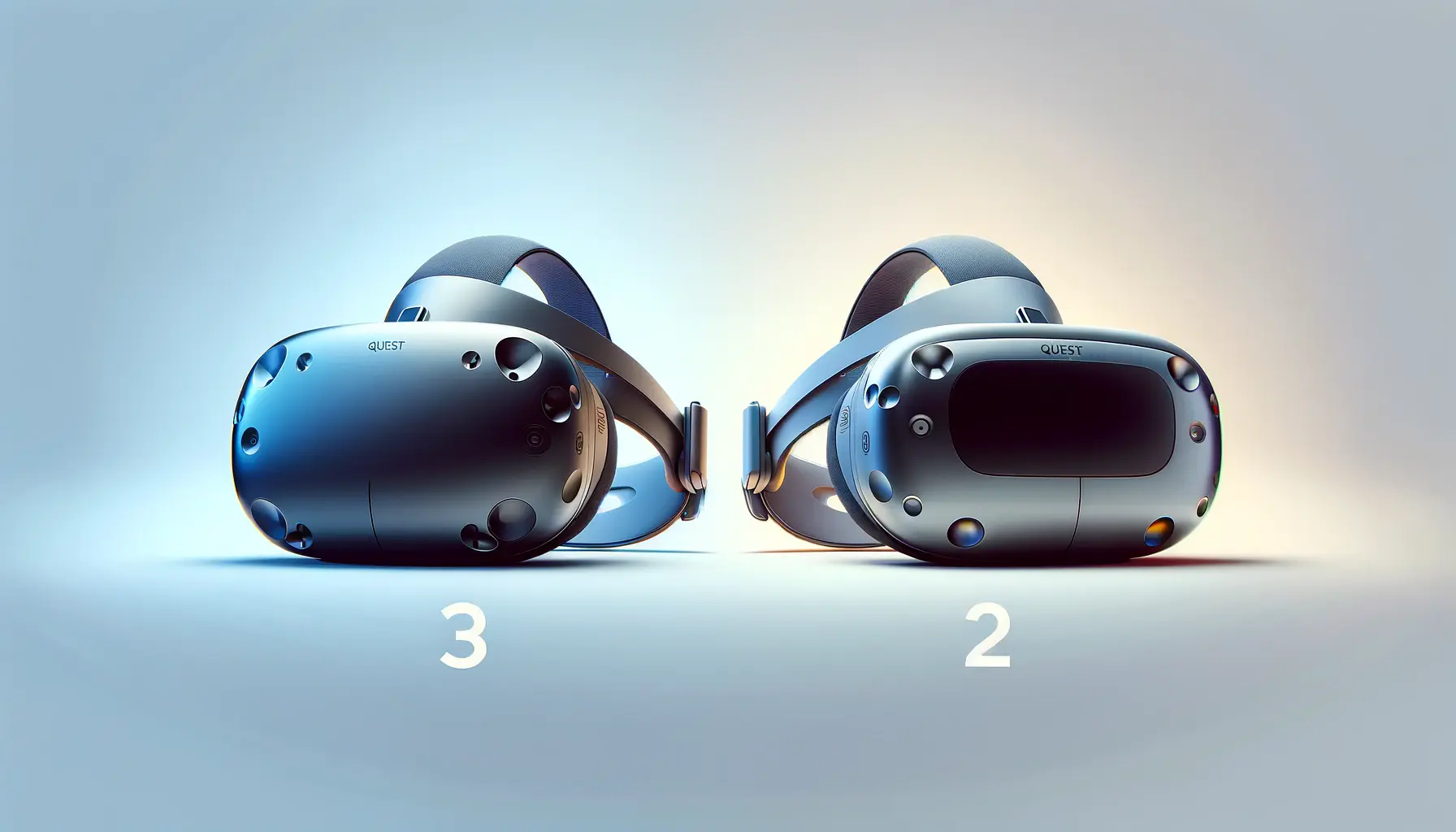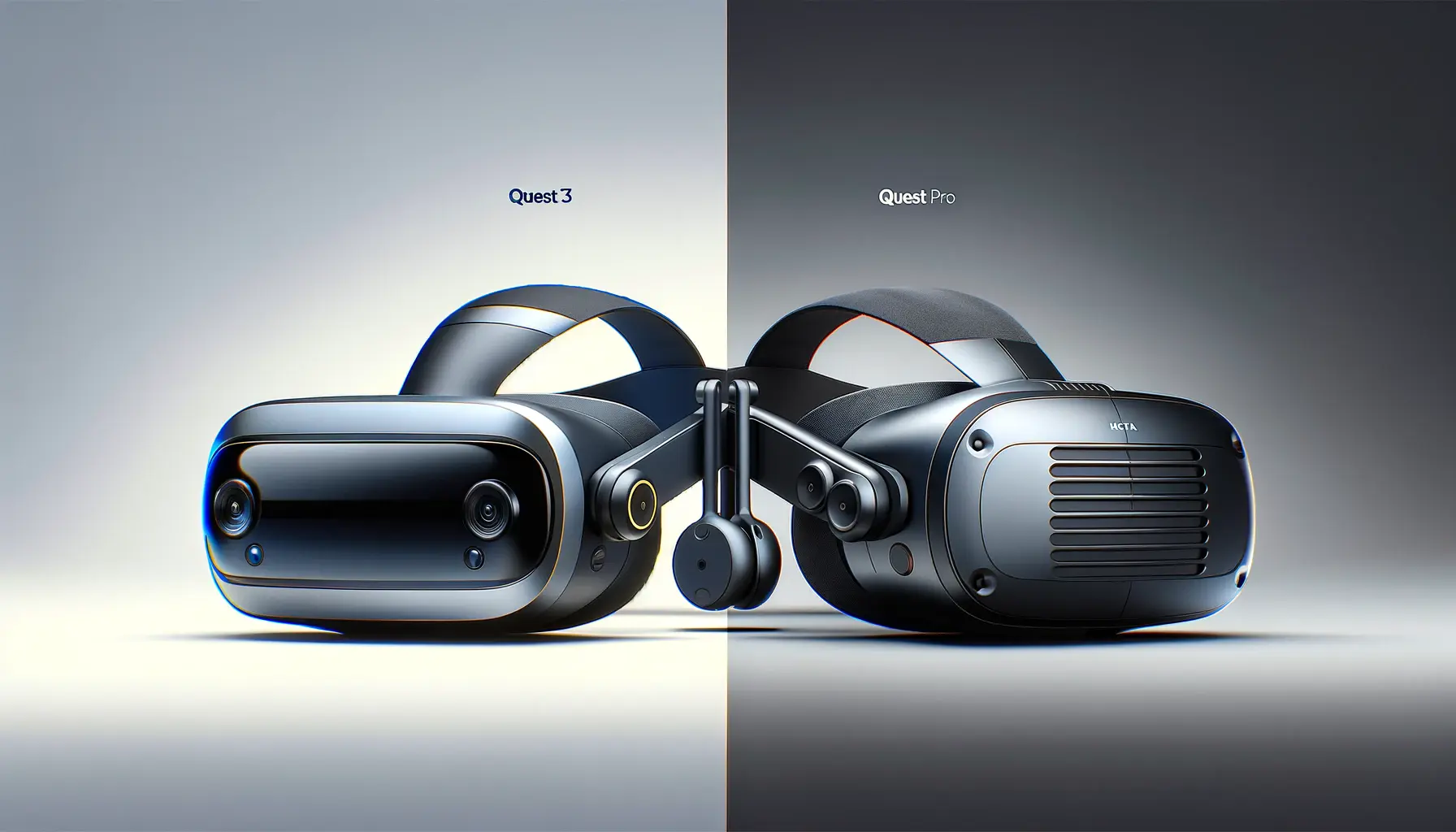The realm of virtual reality (VR) is undergoing a transformative phase, with the Meta Quest 3 at the forefront of this evolution.
This device not only marks a significant leap in VR technology but also redefines the boundaries of connectivity within digital spaces.
The Meta Quest 3, with its advanced features and capabilities, is set to revolutionize how we interact with virtual environments, making it a pivotal moment in the VR industry.
Connectivity, the main keyword and the essence of the Meta Quest 3, is what sets this device apart from its predecessors and competitors.
It’s not just about the hardware’s ability to connect to the internet or other devices; it’s about creating a seamless, integrated experience that transcends traditional VR boundaries.
This article delves into the various aspects of connectivity offered by the Meta Quest 3, exploring how it enhances user experience, fosters community, and pushes the envelope of what’s possible in virtual reality.
- Revolutionizing VR Connectivity
- Integrating the Physical and Virtual Worlds
- Wireless Freedom and Cloud Integration
- Immersive Gaming and Interactive Media
- Enhancing Accessibility and Inclusivity
- Future-Proofing with Upgradable Features
- Empowering Developers and Content Creators
- Charting the Future of Virtual Reality with Meta Quest 3
- Quest 3 Connectivity: Your Questions Answered
Revolutionizing VR Connectivity
The Meta Quest 3 introduces a new era of VR connectivity, emphasizing ease of access, improved social interactions, and enhanced compatibility with external devices.
This device takes a holistic approach to connectivity, ensuring that users can effortlessly transition between virtual and real-world environments without compromising immersion or functionality.
One of the standout features of the Quest 3 is its wireless capabilities, which have been significantly upgraded to offer faster, more reliable connections.
This improvement not only enhances the quality of online multiplayer games but also streamlines the process of downloading content and updates, making the VR experience more fluid and less interrupted by technical limitations.
Enhanced Social Interactions
The Quest 3’s connectivity extends beyond technical specifications, deeply integrating social features that encourage community building and shared experiences.
With the introduction of new social VR platforms and improved friend-list management, users can now connect with friends and like-minded individuals more easily than ever before.
This social connectivity fosters a sense of community within the VR space, making virtual interactions more meaningful and engaging.
Moreover, the Quest 3’s advanced social features are designed to mimic real-life interactions closely, offering users a range of communication tools such as voice chat, gesture recognition, and avatar customization.
These tools not only enhance the realism of social interactions but also provide users with the flexibility to express themselves in unique and creative ways within the VR environment.
The Meta Quest 3’s connectivity is not just about technical advancements; it’s about creating a more immersive, social, and seamless VR experience.
Integrating the Physical and Virtual Worlds
The Meta Quest 3 stands out by blurring the lines between the physical and virtual worlds through its innovative connectivity features.
This integration is achieved through a combination of hardware advancements and software innovations, making the transition between these two realms seamless and intuitive for users.
At the heart of this integration is the Quest 3’s use of mixed reality (MR) technology.
By leveraging high-fidelity color passthrough cameras and spatial awareness technology, the device allows users to interact with their physical environment in ways previously unimaginable in VR.
This not only enhances the realism of virtual experiences but also opens up new possibilities for applications in education, training, and entertainment.
Real-World Applications
The implications of the Quest 3’s connectivity and its ability to integrate the physical and virtual worlds are vast.
Here are some key areas where this technology is set to make a significant impact:
- Education and Training: The Quest 3’s MR capabilities can revolutionize how educational content is delivered, offering immersive, interactive learning experiences that can adapt to the user’s physical environment.
- Remote Work: With the ability to overlay virtual workspaces onto the real world, the Quest 3 can enhance productivity and collaboration among remote teams, making virtual meetings more engaging and effective.
- Entertainment: The integration of physical and virtual worlds allows for new forms of entertainment, from interactive storytelling to immersive concerts and events that users can experience from the comfort of their homes.
Enhancing User Experience with MR
The Quest 3’s mixed reality features not only enhance the device’s connectivity but also significantly improve the overall user experience.
By allowing users to see and interact with their real environment while immersed in VR, the Quest 3 reduces the disorientation and discomfort often associated with prolonged VR use.
This makes the device more accessible and enjoyable for a wider range of users, from seasoned VR enthusiasts to newcomers.
Furthermore, the Quest 3’s MR technology enables a variety of new use cases that were previously difficult or impossible to achieve.
For example, users can now place virtual objects in their physical space, interact with them as if they were real, and even share these experiences with others in real-time.
This level of interaction and connectivity opens up endless possibilities for creativity, collaboration, and exploration within the VR space.
The integration of the physical and virtual worlds through the Meta Quest 3’s connectivity and mixed reality technology marks a significant step forward in the evolution of VR, offering users a more immersive, versatile, and engaging experience.
Wireless Freedom and Cloud Integration
The advent of the Meta Quest 3 has ushered in a new paradigm of wireless freedom and cloud integration in the realm of virtual reality.
This leap forward is not just about cutting the cord but about redefining what connectivity means in a VR context.
The Quest 3’s wireless capabilities are a testament to the device’s commitment to providing a seamless and unrestricted VR experience.
By eliminating the need for physical connections, users can now explore virtual spaces with unprecedented freedom.
This wireless freedom enhances the immersion and realism of VR experiences, allowing users to move and interact within their virtual environments more naturally and intuitively.
Cloud Integration and Accessibility
The Quest 3’s connectivity extends into the cloud, offering users a plethora of benefits that enhance accessibility and convenience:
- Cloud Storage: Users can save their game progress and settings in the cloud, ensuring that their data is secure and accessible from any Quest 3 device.
- Streaming Services: The integration with cloud-based streaming services allows for high-quality streaming of VR content, reducing the need for local storage and processing power.
- Remote Play: Cloud connectivity enables remote play features, allowing users to access their Quest 3 device from a distance, further enhancing the flexibility of when and where VR can be enjoyed.
Expanding the VR Ecosystem
The Quest 3’s wireless and cloud capabilities are pivotal in expanding the VR ecosystem.
By facilitating easier access to a wider range of content and services, the Quest 3 is not just a standalone device but a gateway to a vast virtual universe.
This expansion is crucial for the growth of the VR industry, as it attracts more developers and content creators, leading to a richer and more diverse array of VR experiences for users.
Moreover, cloud integration plays a significant role in the Quest 3’s ability to receive continuous updates and improvements.
This ensures that the device remains at the cutting edge of VR technology, offering users the latest features and enhancements without the need for hardware upgrades.
The dynamic nature of cloud connectivity means that the Quest 3 can evolve over time, adapting to the changing needs and preferences of the VR community.
The Meta Quest 3’s wireless freedom and cloud integration are not just features; they are the foundation of a new VR connectivity paradigm that offers users unparalleled flexibility, accessibility, and a constantly evolving VR experience.
Immersive Gaming and Interactive Media
The Meta Quest 3’s advanced connectivity capabilities have significantly impacted the domains of immersive gaming and interactive media.
By leveraging high-speed wireless technology and cloud integration, the Quest 3 offers an unparalleled gaming experience that is both immersive and interactive.
This device has set a new standard for what gamers and media consumers can expect from virtual reality, pushing the boundaries of imagination and technological innovation.
Gaming on the Quest 3 is not just about playing; it’s about experiencing games in a way that is deeply engaging and profoundly immersive.
The device’s connectivity allows for real-time multiplayer experiences that are smooth and responsive, creating a sense of presence and camaraderie among players that is unmatched in traditional gaming setups.
Next-Level Interactive Media
Beyond gaming, the Quest 3’s connectivity enriches the consumption of interactive media, offering users new ways to experience storytelling, education, and entertainment.
Here’s how the Quest 3 is revolutionizing interactive media:
- Interactive Storytelling: Users can become part of the story, making choices that influence the narrative’s outcome in real-time, thanks to the device’s seamless connectivity and processing power.
- Educational Experiences: The Quest 3 provides immersive educational content that is more engaging and effective, allowing learners to explore historical sites, dissect complex molecules, or practice language skills in virtual environments.
- Virtual Events: With the Quest 3, attending concerts, conferences, and social gatherings in virtual spaces becomes a rich, interactive experience, offering users a sense of participation and presence that rivals physical attendance.
Enhancing User Engagement
The Quest 3’s impact on gaming and interactive media is not just about the technological advancements it brings; it’s also about how it enhances user engagement.
The device’s ability to connect users with content in a deeply immersive and interactive manner leads to higher levels of engagement and satisfaction.
This increased engagement is crucial for content creators and developers, as it opens up new avenues for creativity and innovation, encouraging the development of content that is not only entertaining but also meaningful and impactful.
Furthermore, the Quest 3’s connectivity features, such as social integration and cloud-based services, ensure that users have a continuous stream of content and experiences to explore.
This keeps the VR ecosystem vibrant and dynamic, constantly offering new challenges and discoveries that keep users engaged and invested in the virtual world.
The Meta Quest 3 is redefining immersive gaming and interactive media, offering users an unparalleled experience that is both deeply engaging and endlessly captivating, thanks to its advanced connectivity and innovative features.
Enhancing Accessibility and Inclusivity
The Meta Quest 3’s connectivity features play a crucial role in enhancing accessibility and inclusivity within the virtual reality landscape.
By prioritizing seamless integration and user-friendly interfaces, the Quest 3 ensures that VR is accessible to a broader audience, including those who may have previously found the technology intimidating or challenging to navigate.
This commitment to accessibility is a significant step towards creating a more inclusive digital world where everyone can enjoy the benefits of virtual reality.
Accessibility in VR is about more than just physical access to the technology; it’s about creating experiences that are meaningful and enjoyable for all users, regardless of their physical abilities or technical expertise.
The Quest 3 addresses this through intuitive design, customizable settings, and features that accommodate a wide range of needs and preferences.
Customizable User Experiences
The Quest 3 offers a variety of customization options that allow users to tailor their VR experience to their individual needs.
These features include:
- Adjustable Control Settings: Users can modify control schemes to suit their comfort and accessibility needs, making VR experiences more enjoyable and less physically demanding.
- Visual and Audio Adjustments: The device provides options to adjust visual contrast, color settings, and audio cues, catering to users with visual or auditory impairments.
- Virtual Assistance: Built-in virtual assistants and voice commands reduce the reliance on physical navigation, enhancing accessibility for users with limited mobility.
Building a Community for All
Beyond individual user experiences, the Quest 3’s connectivity fosters a sense of community and belonging among VR users.
By facilitating social interactions and shared experiences in virtual spaces, the device brings people together, transcending physical limitations and geographical boundaries.
This social connectivity is vital for creating an inclusive environment where users can find support, friendship, and a sense of belonging.
The Quest 3’s emphasis on accessibility and inclusivity is not just about adhering to standards; it’s about recognizing the diverse needs of the VR community and actively working to meet those needs.
By doing so, Meta is ensuring that virtual reality becomes a tool for empowerment and connection, accessible to everyone, regardless of their background or abilities.
The Meta Quest 3’s focus on enhancing accessibility and inclusivity is transforming virtual reality into a more welcoming and empowering space for all users, making it a pivotal tool for social connection and community building.
Future-Proofing with Upgradable Features
The Meta Quest 3 is designed not just for the present but with an eye towards the future.
Its connectivity capabilities are a cornerstone of this forward-thinking design, allowing the device to adapt and evolve through upgradable features and software updates.
This approach to future-proofing ensures that the Quest 3 remains at the forefront of VR technology, providing users with a device that grows and improves over time.
One of the key aspects of the Quest 3’s future-proof design is its modular architecture.
This allows for hardware components to be updated or replaced as new advancements become available, extending the device’s lifespan and enhancing its performance without requiring users to purchase a new headset.
Software Updates and New Features
Software updates play a crucial role in the Quest 3’s ability to stay relevant and cutting-edge.
These updates include:
- Performance Enhancements: Regular updates improve the device’s efficiency and processing power, ensuring smooth and immersive VR experiences.
- New Functionalities: The introduction of new features and capabilities through software updates keeps the Quest 3 innovative, offering users new ways to explore and interact with virtual environments.
- Security Improvements: Continuous updates to the device’s security protocols protect users’ data and privacy, maintaining the integrity of their virtual experiences.
Adapting to Changing User Needs
The Quest 3’s upgradable features and software updates are not just about maintaining technical relevance; they’re about adapting to the changing needs and preferences of the VR community.
As virtual reality evolves, so do the expectations and demands of its users.
The Quest 3’s flexible design ensures that it can meet these changing needs, providing a personalized and up-to-date VR experience for each user.
This adaptability is crucial for fostering long-term user engagement and satisfaction.
By continuously enhancing the Quest 3’s features and capabilities, Meta ensures that users remain excited and invested in their VR journeys.
This commitment to innovation and improvement is what sets the Quest 3 apart, making it a truly future-proof device that is ready to grow and evolve with the virtual reality landscape.
Contrary to the notion that technology quickly becomes obsolete, the Meta Quest 3’s upgradable features and software updates ensure it remains a dynamic and evolving platform for virtual reality experiences.
Empowering Developers and Content Creators
The Meta Quest 3’s connectivity capabilities extend beyond the user experience, offering a robust platform for developers and content creators to innovate and thrive.
By providing advanced tools and an open ecosystem, the Quest 3 empowers creators to push the boundaries of VR content, leading to richer, more diverse experiences for users.
This symbiotic relationship between hardware capabilities and creative content is pivotal for the continued growth and evolution of the VR industry.
Developers and content creators are at the heart of the VR experience, crafting the immersive worlds and interactive experiences that define the medium.
The Quest 3 supports these creators with a suite of development tools designed to leverage the device’s connectivity and capabilities, enabling them to bring their visions to life with unprecedented ease and flexibility.
Supporting Creative Innovation
The Quest 3 offers various features and resources to support creative innovation:
- Comprehensive SDKs: Software development kits provide developers with the tools they need to create complex VR applications, taking full advantage of the Quest 3’s hardware.
- Cloud-Based Development: Cloud integration facilitates collaborative development processes, allowing teams to work together seamlessly, regardless of their physical location.
- Marketplace Visibility: The Quest 3’s marketplace offers a platform for creators to showcase their work, reaching a wide audience of VR enthusiasts eager for new experiences.
Fostering a Thriving VR Ecosystem
By empowering developers and content creators, the Quest 3 plays a crucial role in fostering a thriving VR ecosystem.
This ecosystem is characterized by a virtuous cycle of innovation, where new technologies inspire creative content, which in turn drives demand for more advanced hardware.
The Quest 3’s connectivity and upgradable features ensure that it remains a central hub for this ongoing cycle of innovation, providing a stable platform for the development of future VR experiences.
The impact of the Quest 3 on the developer and creator community extends beyond the technical.
It signifies Meta’s commitment to supporting the creative forces that drive the VR industry forward.
By offering a platform that is both powerful and accessible, the Quest 3 encourages a diverse range of voices and perspectives to contribute to the VR landscape, enriching the medium for all users.
The Meta Quest 3’s role in empowering developers and content creators is a testament to its significance not just as a piece of hardware, but as a catalyst for innovation and creativity in the virtual reality industry.
Charting the Future of Virtual Reality with Meta Quest 3
The Meta Quest 3 represents a significant leap forward in the realm of virtual reality, setting new standards for connectivity, immersion, and user engagement.
As we’ve explored throughout this article, the Quest 3 is not merely a device but a comprehensive platform that redefines the boundaries of digital interaction.
Its impact on gaming, social connectivity, content creation, and beyond illustrates the transformative potential of advanced VR technologies.
The Quest 3’s Role in Shaping VR Connectivity
At the core of the Quest 3’s innovation is its unparalleled approach to connectivity.
This device has demonstrated that the future of VR lies in creating seamless, integrated experiences that bridge the gap between the virtual and the physical, the individual and the community.
Through features like wireless freedom, cloud integration, and mixed reality capabilities, the Quest 3 offers users a glimpse into a future where virtual spaces are as accessible and interactive as the real world.
Empowering Users and Creators Alike
The Quest 3 stands out not just for its technical prowess but for its commitment to accessibility, inclusivity, and empowerment.
By designing a device that caters to a wide range of needs and preferences, Meta ensures that VR is a tool for everyone—regardless of their background or abilities.
Furthermore, the Quest 3’s support for developers and content creators fosters a vibrant ecosystem of innovation, where new ideas and experiences can flourish.
This collaborative approach is crucial for the sustained growth and diversification of the VR industry.
- Enhanced Social Interactions: The Quest 3’s connectivity transforms virtual socialization, making it more immersive and authentic.
- Wireless Freedom: Untethered experiences allow users to explore virtual worlds with unprecedented freedom.
- Cloud Integration: Access to cloud-based services and content ensures that the Quest 3 remains a dynamic, evolving platform.
- Accessibility and Inclusivity: Features designed to accommodate diverse user needs make VR more accessible to a broader audience.
- Future-Proof Design: Upgradable features and software updates ensure that the Quest 3 remains at the cutting edge of VR technology.
- Support for Creators: By providing robust development tools and marketplace visibility, the Quest 3 empowers creators to innovate and thrive.
In conclusion, the Meta Quest 3 is more than just the next step in VR hardware; it’s a vision for the future of digital connectivity.
By seamlessly integrating advanced technology with user-centric design, the Quest 3 invites us to explore new worlds, connect with others, and express ourselves in ways we’ve only begun to imagine.
As we look forward to the continued evolution of virtual reality, the Quest 3 stands as a beacon of innovation, inclusivity, and endless possibility.
Quest 3 Connectivity: Your Questions Answered
Explore the most common inquiries about the Meta Quest 3’s connectivity features and capabilities.
Connect your Quest 3 to Wi-Fi by selecting your network, entering the password on the headset, or scanning a QR code from the Meta Quest mobile app.
Yes, Air Link allows you to connect the Quest 3 wirelessly to your PC, enabling a seamless VR experience without the need for a cable.
While the Quest 3 comes with advanced connectivity options, future software updates may enhance its capabilities or introduce new features.
If your Quest 3 can’t connect to Wi-Fi, restart the headset, check your router settings, or reset your Wi-Fi network from the device’s settings.
Yes, Quest 3 can connect to compatible smartphones and certain peripherals via Bluetooth for a more integrated VR experience.
Quest 3 supports multiplayer gaming through its Wi-Fi connectivity, allowing for smooth and responsive online interactions with other players.
Various accessories, like the Quest Link cable, can enhance connectivity, especially for PC VR gaming, offering a more stable connection.
Quest 3 supports cloud gaming and streaming services, allowing users to play high-quality VR games without needing extensive local storage.













